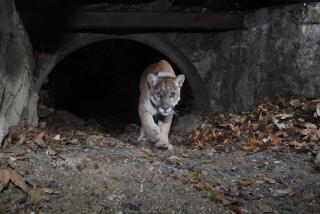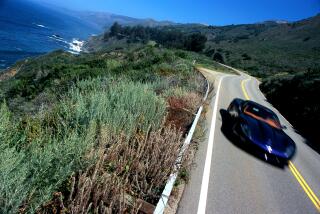Plight of the ‘Chain Monkeys’
- Share via
Most “chain monkeys” agree that one of the biggest problems with their job is the unfortunate tendency for customers to run them over.
It happened to Chris Lotito. He was putting tire chains on a car along Interstate 80 in the snowy Sierra east of Sacramento. The vehicle suddenly lurched backward and rolled over his hand.
Lotito wrapped his bleeding fingers in a towel and began the hourlong drive in a blizzard to a hospital. “On the way there, my hand began to thaw,” he recalled. “That’s when it really got painful.”
Besides the hazard of getting squashed by a car, the job of installing tire chains during raging snowstorms is fraught with other perils, including frostbite and hypothermia.
“Take a cold shower and get good and wet, put your clothes back on, and then go sit in a freezer for 12 hours,” Lotito said of his work. “None of us are up there for our health. But I’ve got three kids in college, and that’s from installing chains.”
The days of the big paydays, however, are fading for the 400 or so registered chain installers who spend hours shivering along the sides of the state’s snowiest roads. The popularity of four-wheel-drive cars and SUVs -- which usually don’t require chains -- has cut heavily into their business, as has an effort by Caltrans in recent years to step up the plowing of mountain roads.
“We’re a dying breed,” Lotito said. “I’m really the last of the mountain men.”
Chain monkeys have been around since cars first hit the road. But the job really came into its own in the 1960s and ‘70s in the Sierra Nevada, as new ski resorts opened and more people began driving from the cities up into the mountains.
Installing chains was a way for construction workers and loggers to earn extra money during the winter -- or to pay for a winter playing on the slopes.
Tire chains give cars traction on ice and snow. During winter storms, Caltrans and the California Highway Patrol often require motorists to put on chains before driving across the mountains. But putting chains on cars can be difficult, particularly for those who have little experience.
They are sold in small boxes and have a tendency to come out of their packages in knots that would confound an Eagle Scout. And putting the chains on correctly means crawling under a car and joining the links on the inside of the tire. Put them on wrong and they can wrap around an axle, stopping the vehicle in its tracks.
Chain monkeys, also known as chain apes, are a reasonable alternative for many people. They charge $20 for putting on chains and $10 for removing them, the maximum recommended by the state.
It’s a job both physically taxing and risky. Knee pads and thin gloves offer little protection during hours of work under and around cars in ice and snow. For a quick warmup, installers often wrap their gloved hands around a vehicle’s tailpipe.
In 1999, the employment service firm Aramark ranked the snow-tire chain installer as the fourth-most-dangerous job in the United States, behind tugboat workers in the North Atlantic, search-and-rescue rangers at the Grand Canyon and those who stand under air-conditioning units as they are lowered by crane onto the roofs of buildings.
For chain monkeys, a big part of the appeal is the unpredictable weather and the mystery of who next will come skidding down the road.
Frank Stewart grew up in the San Fernando Valley and spent summers backpacking and fishing in the Sierra. He started installing tire chains along U.S. 395 in the Eastern Sierra in the early 1980s because he loved living in the mountains. Stewart, 50, now owns a general contracting firm near Bishop but continues to stand at the edge of the highway when big storms hit.
“You put yourself right out there in the elements and see what you can catch,” he said. “I tell people it’s like fishing for salmon. You only catch them when they are running.”
Stewart said the change in his business can be seen in the hulking SUVs that now dominate 395 and other mountain roads that were once largely the domain of two-wheel-drive cars. When he started, nine in 10 cars needed to chain up. Today, it’s two or three cars in 10. Indeed, many skiers say they bought SUVs so they could avoid hassling with chains.
As independent contractors, chain monkeys must buy annual $160 permits from Caltrans, the state agency that maintains California’s roads. The state decided to regulate the installers 20 years ago after complaints by motorists that some unscrupulous operators were putting chains on incorrectly.
Before officials award a permit, the applicant must visit a Caltrans office for a test that involves untangling a set of chains and putting them on a car in less than five minutes.
Lotito, 48, claims the state record of 47 seconds. He got his first taste of the profession in 1977 when he was 21. He had just lost a leg in a motorcycle accident and was looking for work during the winter. Lotito earned $40 the first day, a huge sum to him at the time. He’s done the job every winter since, working construction the rest of the year.
“It’s not that hard to put the chains on,” he said. “What’s hard is standing out there freezing ... while doing it. We’re usually facing the storm while working and getting pelted with snow and ice and 50- to 60-mph winds right smack in the face.”
He made about $23,000 last winter, but he’s short of that pace this year, in large part because of this winter’s unusually dry conditions.
Lotito began noticing a decline in the early 1990s, just as a four-year drought was ending and the SUV craze was beginning. Things seem to get worse each season, he said. Now, many of his friends are taking second winter jobs because they can’t make a living simply installing chains.
Others have started chaining big rigs exclusively. They can make as much as $120 a job, but it’s hard work: Each truck chain weighs about 100 pounds. Some freight companies have concluded that the work is so hazardous that they recommend their drivers farm out the work to chain monkeys rather than do it themselves.
“These guys who drive the trucks are not exactly what you’d consider specimens of physical agility,” said Stan Richins, a Caltrans official who has overseen chain installers for 20 years in the central Sierra.
Without the chain monkeys, “those roads would be impossible in the winter,” Richins said. But he also recognizes that there is no longer enough work to keep all the installers busy. So, Caltrans plans to reduce the number of installers in the district around Interstate 80 from 120 to 50 over the next five years.
With work so scarce, chain monkeys must always be on the lookout for an opportunity.
Chris Bennett, a 37-year-old UPS driver from Yreka who moonlights as a chain monkey, was driving Interstate 5 near Mt. Shasta when a sudden snow squall kicked up last year. A truck jackknifed, blocking all lanes. Bennett got out of his car and proceeded to ask stranded motorists if they needed chains installed. A handful took him up on his offer.
Though most chain monkeys have been around for years, each season brings an infusion of new blood. Matt Wolcott, a 26-year-old snowboarder, is completing his second year as an installer at a gas station along Interstate 80 near Donner Pass.
He had hoped to earn enough money to spend most of his time on the slopes. But the decline in business forced him indoors; he now works as a hotel porter at a local ski resort. “I’d really rather be chaining,” he said.
Still, the camaraderie along the highway remains. If a storm is forecast for Friday, some chain monkeys will camp out on the side of the road beginning Tuesday to claim a prime spot. During heavy weekend storms, they might work 48 to 72 hours straight because the money is too good to stop.
They pass the time playing cards, reading or competing to see who is quickest at chaining a car while blindfolded.
And they swap tales. An SUV driver once popped the rear door so Chris Lotito could grab the vehicle’s chains. Lotito found them under a stretcher holding a body apparently bound for a morgue. “Don’t worry about him,” Lotito recalled the driver, whom he took for a mortuary worker, saying. “He doesn’t mind the cold.”
Another time, Lotito said, he poked his head inside the car of an elderly couple and was astonished to see the interior filled with hundred-dollar bills. The couple had just won big at keno over the hill in Reno. They paid Lotito $200 to put on chains -- even after he dropped the old man’s bottle of booze.
Lotito and other chain monkeys say that when motorists don’t have money, they often barter for the service.
Jay Welden, a 48-year-old construction worker and veteran installer along U.S. 50 near Echo Summit, said he has done the work in exchange for compact discs or food: turkeys, doughnuts, T-bone steaks. “They were good,” he said of the steaks.
Another time, Welden and a friend placed chains on a car. His friend got into an intense conversation with a woman passenger, then hopped into the car and drove away with her.
He returned two days later.
Stewart said he has put on chains for Arnold Schwarzenegger, Whoopi Goldberg, Eddie Murphy and Dudley Moore. “A few years ago, I chained up Jenny McCarthy,” he said.
McCarthy, an actress and former Playboy Playmate of the Year, was riding in a limousine with tinted windows that pulled up at 4 a.m. The driver of another car in her entourage was kind enough to open the limo door for Stewart to get a peek.
“And I’m standing there like a grinning idiot, holding the chains,” he said.
He went to work. Then the car pulled away, leaving Stewart cold and alone in a snowy landscape on a dark and stormy night.
He says he can’t think of anyplace he would rather have been.






